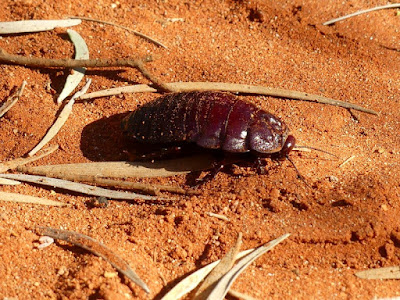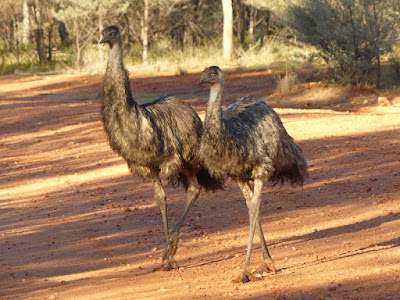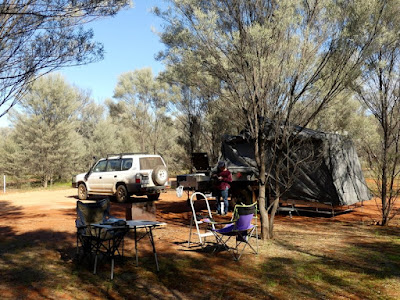When I was a young feller growing up in Adelaide, the phrase 'back of Bourke' (an idiom for somewhere very remote and 'outback') evoked strong emotions in me; I really wanted to explore 'out there'. I did so eventually but it took a long time (and I confess that the town of Bourke no longer seems so remote!). In this semi-arid area of central northern New South Wales are several valuable reserves, one of the largest and most impressive of them being Gundabooka National Park. This park, along with the adjacent Gundabooka State Conservation Area, covers some 94,000 hectares of varied dry country landscapes about 70km south of Bourke, to the west of the highway to Cobar. Moreover the Toorale National Park and State Conservation Area, across the Darling River to the north-west, adds another 85,000 hectares to form a massive reserve system.
(There is a significant and unfortunate caveat here though: in a State Conservation Area minerals and petroleum exploration and mining 'may be permitted', which would considerably reduce the value of the reserve. As far I am aware no such activities are currently planned for these areas, but the option is there.)
The park was gazetted in 1996 and covered 46,000 hectares, comprising the former pastoral leases of Ben Lomond and Belah; the 20,000ha of Mulgowan station were added to the south in 2002. Finally Yanda's 28,000ha in 2005 became the Gundabooka State Conservation Area to the north.
 |
| Approximate position of Gundabooka, just south of Bourke. (It's fuzzier than I'd like, apologies.) |
 |
| I have found it surprisingly difficult to find a usable map (or indeed any map) of the park - this is a real flaw of the New South Wales National Parks and Wildlife Service (NPWS) web site (probably a spinoff of their lack of resources). This one is taken from the management plan of the park, but in the process has lost most of its useful definition. To give you a slightly better idea I've added the red numbers. 1 is the main access to the park, along Ben Lomond Road off the Bourke-Cobar Highway. 2 is the Dry Tank campground and picnic ground (the only campground in the national park itself), and the walk to Little Mountain. 3 is the Yapa (Mulgowan) art site on Mulareenya Creek. 4 is the Bourke to Louth road along the Darling River. 5 is the Yanda campground on the Darling River in the State Conservation Area. (Actually if you click on it to enlarge it, it's not too bad.) |
 |
| Drifts of mulga phyllodes (pseudo-leaves) across the ground left by recent flash flooding in the campground; new growth is coming through. |
 |
| Much of the Mulga was flowering, in response to the earlier rains. |
 |
| Bimble Box, above and below. |
This tree was growing along the very pleasant walking track to Little Mountain Lookout, which leads out of the campground/picnic ground.
There was however one worrying aspect about the trees that we hadn't previously encountered.
 |
| After a while with no such ambushes we decided that perhaps they were only dangerous during breeding season? |
 |
| Mount Gunderbooka across the mulga from Little Mountain Lookout. It is the highest point in the vicinity, 500 metres above sea level and some 300-350 metres above the surrounding plains. |
 |
| Narrow-leaf Waxflower Philotheca (formerly Eriostemon) linearis, another shrub in flower at the lookout when we were there. It is scattered in rocky habitats in dry inland NSW and South Australia. |
The other walking track we took was the short one to the Yapa (Mulgowan) art site in the far south of the park, accessed by a well-signposted road to the south off Ben Lomond Road (7.5k from the park entrance, 12k back from the campground). When we were there we encountered a sign warning of ‘rough road, drive with care’, but in the event it was smoother than the Ben Lomond Road. The walk itself is only 700 metres each way and quite easy on a good track over a low rocky ridge to the Mulareenya Creek; the warning on the website about this 'challenging yet rewarding walking track' should be treated as a somewhat extreme example of the precautionary principle. This is a site of great significance to the Ngemba and Baakandji people, who co-manage the park through a Memorandum of Understanding with the Head of NSW National Parks and Wildlife Service, which commits both parties to cooperatively manage both the cultural and natural heritage of the reserves.
A feature of our walk was the profusion of flowering Wonga Vine Pandorea pandorana sprawling over rocks and other vegetation.
 |
| Wonga Vine is a spectacular climber when in flower. |
 |
| A typical scene along the walk, with reddish sandstone boulders, Wilga Geijera parviflora and White Cypress Pine Callitris glaucophylla. |
 |
| The view across Mulyareena Creek to the art site among the boulders and cliffs opposite. |
 |
| Trees present include Coolabah Apple Angophora melanoxylon, Bimble Box and the somewhat curious Supplejack Ventilago viminalis. |
 |
| This Supplejack tree began life as a small climber, scrambling through other vegetation, then later developed a woody trunk to become a tree. Its family is Rhamnaceae. |
 |
| My uneducated guess for this cockroach is Panesthia australis, a nymph which hasn't yet developed wings. |
 |
| My best offering for this one is one of the slant-faced grasshoppers, Family Acrididae. |
 |
| Termite runway covered in soil to protect them from sunlight. |
 |
| Part of the same family crossing the camp road early one morning. |
 |
| Red-capped Robins Petroica goodenovii were the other camp bird. We'd never seen so many in a campground before! However as this photo suggests they weren't nearly as easy to approach as the Emus were. |
I've just realised that the rest of these bird photos were all taken around the campground too, with the exception of the falcon.
 |
| Brown Falcon Falco berigora sitting by the road on the drive back from the Yapa art site. A common raptor over the entire continent, but no bird which is being so obliging deserves to be ignored. |
 |
| This Horsfield's Bronze-Cuckoo Chalcites basalis was calling from an exposed perch, which is typical cuckoo behaviour. The fairywrens will need to be especially vigilant when they start breeding! |
 |
| And lastly this is a particularly abiding image for me of those morning walks, a gorgeous male Mulga Parrot Psephotellus varius sitting up in the sun and calling loudly. |
Should you wish to be added to it, just send me an email at calochilus51@internode.on.net. You can ask to be removed from the list at any time,or could simply mark an email as Spam, so you won't see future ones.
If you do leave a comment - and I love it when you do - please remember to click the
box below your comment that says 'Email follow-up comments to...[your address]'
so you'll know when I reply - and I always do!














